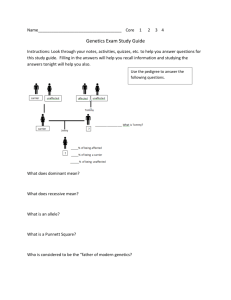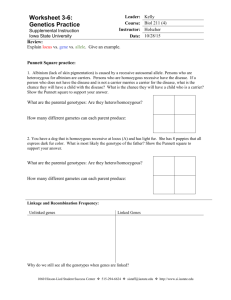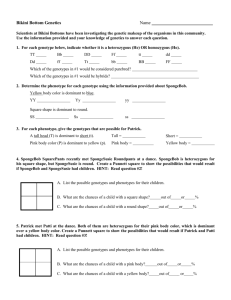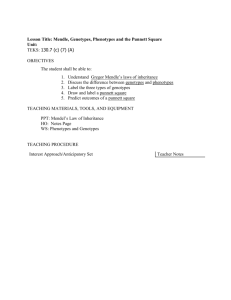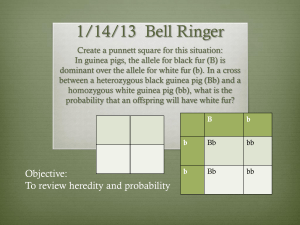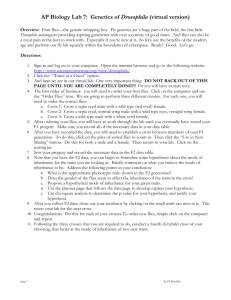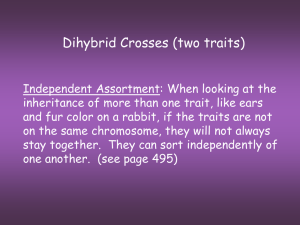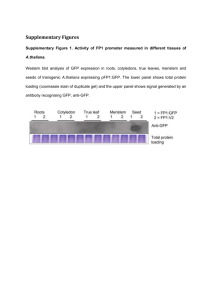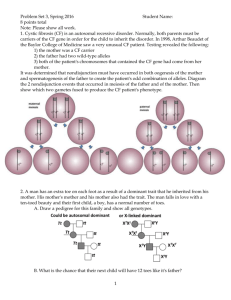Real Fly Lab Wild White + Vestigial Lab WKST
advertisement
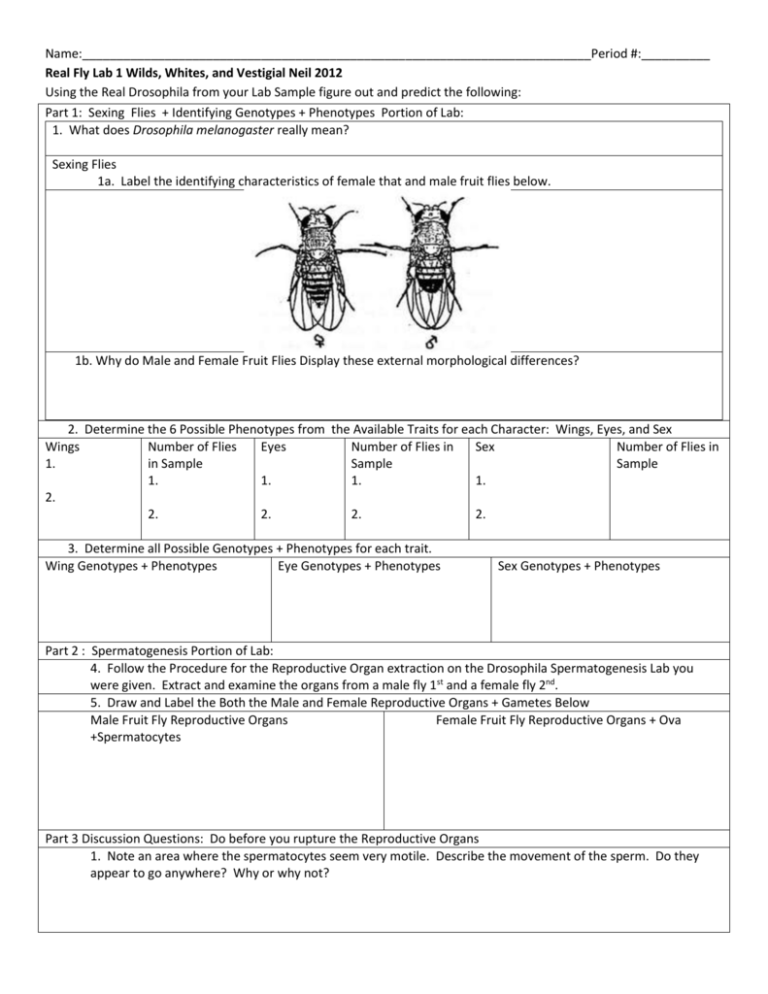
Name:__________________________________________________________________________Period #:__________ Real Fly Lab 1 Wilds, Whites, and Vestigial Neil 2012 Using the Real Drosophila from your Lab Sample figure out and predict the following: Part 1: Sexing Flies + Identifying Genotypes + Phenotypes Portion of Lab: 1. What does Drosophila melanogaster really mean? Sexing Flies 1a. Label the identifying characteristics of female that and male fruit flies below. 1b. Why do Male and Female Fruit Flies Display these external morphological differences? 2. Determine the 6 Possible Phenotypes from the Available Traits for each Character: Wings, Eyes, and Sex Wings Number of Flies Eyes Number of Flies in Sex Number of Flies in 1. in Sample Sample Sample 1. 1. 1. 1. 2. 2. 2. 2. 2. 3. Determine all Possible Genotypes + Phenotypes for each trait. Wing Genotypes + Phenotypes Eye Genotypes + Phenotypes Sex Genotypes + Phenotypes Part 2 : Spermatogenesis Portion of Lab: 4. Follow the Procedure for the Reproductive Organ extraction on the Drosophila Spermatogenesis Lab you were given. Extract and examine the organs from a male fly 1st and a female fly 2nd. 5. Draw and Label the Both the Male and Female Reproductive Organs + Gametes Below Male Fruit Fly Reproductive Organs Female Fruit Fly Reproductive Organs + Ova +Spermatocytes Part 3 Discussion Questions: Do before you rupture the Reproductive Organs 1. Note an area where the spermatocytes seem very motile. Describe the movement of the sperm. Do they appear to go anywhere? Why or why not? 2. Note an area where the sperm do not seem to move at all. Describe the organization of the sperm in that location. How many sperm are in the same area? What prevents their movement? 3. Speculate about a condition that might affect sperm movement and design an experiment to test your hypothesis? 4a. Why do Male and Female Fruit Flies Display these internal morphological differences in relation to their reproductive organs? 4b. How do these internal morphological differences relate to the external morphological differences? 4. How do the Relative Sizes, Numbers, and Structures of the reproductive organs of Drosophila melanogaster compare with those of Homo sapiens ? (You should have some background knowledge on this from your previous studies in health class?) 5. Why are we looking at fruit fly reproductive organs? What is their importance to the study of biology? Part 4: Using the Real Drosophila from your Lab Sample figure out and predict the following: For The following Theoretical Crosses 1. Write the Genotypic Code for each of the following crosses 2. Draw Punnett Square for the Following Crosses 3. Determine the Genotypic Ratio for the progeny of each cross 4. Determine the Phenotypic Ratios of the progeny of each cross. 5. Determine what name(s) you would call the cross by. 6. Determine if the traits involved are autosomal, sex linked, or involve gene linkage. Cross A Heterozygous Wild Type Winged Male x Homozygous Vestigial Female 1. Write the Genotypes for this cross 2. Draw Punnett Square for this Cross 1. Determine the Genotypic Ratios for the progeny of this cross 2. Determine the Phenotypic Ratios of the progeny of this cross. 5. Determine what name(s) you could call this cross by: 6. Determine if the traits involved are autosomal, sex linked, or involve gene linkage, explain how you figured this out Cross B Heterozygous Wild Type Winged Male x Heterozygous Wild Type Winged Female 1. Write the Genotypes for this cross 2. Draw Punnett Square for this Cross 3. Determine the Genotypic Ratios for the progeny of this cross 4. Determine the Phenotypic Ratios of the progeny of this cross. 5. Determine what name(s) you could call this cross by: 6. Determine if the traits involved are autosomal, sex linked, or involve gene linkage, explain how you figured this out Cross C Heterozygous Wild eyed Male x Homozygous White Eyed Female 1. Write the Genotypes for this cross 2. Draw Punnett Square for this Cross 3. Determine the Genotypic Ratios for the progeny of this cross 4. Determine the Phenotypic Ratios of the progeny of this cross. 5. Determine what name(s) you would call the cross by. 6. Determine if the traits involved are autosomal, sex linked, or involve gene linkage, explain how you figured this out Cross D Heterozygous Wild Type Winged/Heterozygous Wild Type Eyed Male x Heterozygous Wild Type Winged/Heterozygous Wild Type Eyed Female 1. Write the Genotypes for this cross 2. Draw Punnett Square for this Cross 3. Determine the Genotypic Ratios for the progeny of this cross 4. Determine the Phenotypic Ratios of the progeny of this cross. 5. Determine what name(s) you would call the cross by. 6. Determine if the traits involved are autosomal, sex linked, or involve gene linkage, explain how you figured this out Cross Your Choice Come Up with a New (Different) Cross of you own using the available traits for each character 1. Write the Genotypes for this cross 2. Draw Punnett Square for this Cross 3. Determine the Genotypic Ratios for the progeny of this cross 4. Determine the Phenotypic Ratios of the progeny of this cross. 5. Determine what name(s) you would call the cross by. 6. Determine if the traits involved are autosomal, sex linked, or involve gene linkage, explain how you figured this out ***7. What kinds of information could each of these different types of crosses help you to figure out?

